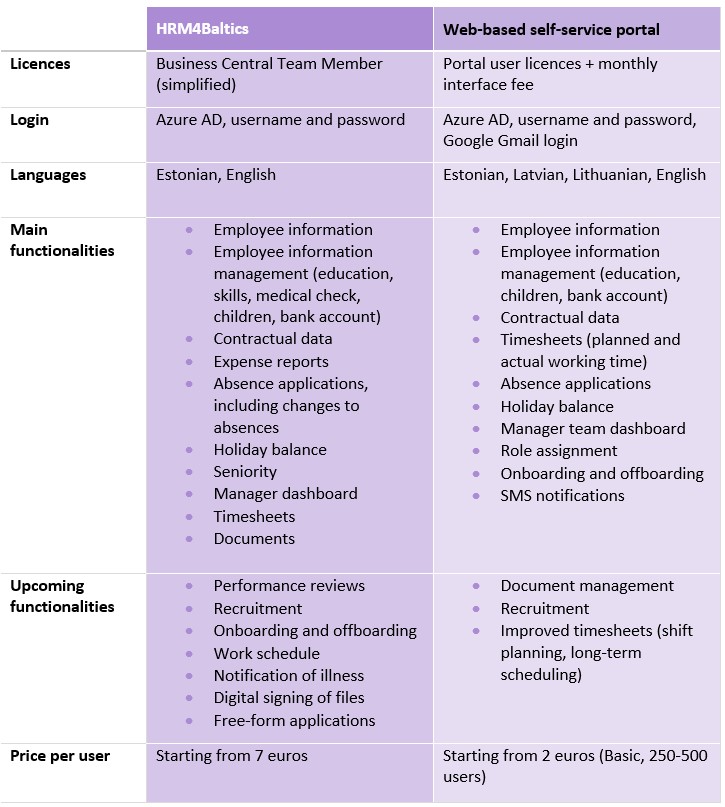Which employee self-service portal to choose?
Source: Äri-IT Spring 2023
Author: Merilin Aug, BCS Itera Project Manager
The practice of employees performing their daily work-related tasks through the employee self-service portal has become quite common. Traditionally, these portals are used to manage leave applications, requests, timesheets and personal data modifications, among other things.

The HRM4Baltics solution (replacing Palk365 and Personal365) also offers the opportunity to use a self-service portal – in fact, there are two to choose from. The Personal365 self-service portal is integrated with HRM4Baltics and, alternatively, there is also an integration with the web-based self-service portal.
Web-based self-service portal
The web-based self-service portal is better suited for larger companies seeking to oversee the main self-service functions on a self-service platform. The price per user of portal is more affordable when there are more users. The web-based self-service portal is available in Estonian, English, Latvian and Lithuanian.
HRM4Baltics
The HRM4Baltics portal, on the other hand, is better suited for small or medium-sized enterprises that have more complex and specific needs and requirements for using the portal. The HRM4Baltics portal is available in Estonian and English.
Differences
The biggest difference between the two portals lies in the fact that the HRM4Baltics in-product portal is directly integrated with Microsoft Business Central and requires its user licences. Web-based self-service portal, however, is separate from Business Central and the user licences are thus also different. In the case of web-based self-service portal, the price of licences depends on the number of users, whereas the HRM4Baltics portal requires all users to have a simplified Team Member licence.
Functionality
Both portals have a lot in common in terms of functionality. For instance, in both portals, it is possible to see standard information about employees: the total number of employees, work anniversaries, absences and company news. In addition, both self-service platforms allow users to apply for leave, view their holiday balance and payslips, and change their personal data. The portals also provide an overview of the assets assigned to employees and allow managers to quickly find information about employees.
Nevertheless, the self-service portals also have differences. For example, in the HRM4Baltics portal, an application can be submitted to change the basic exemption, whereas this particular functionality is absent in the web-based self-service portal. The web-based self-service portal allows employees to request advances, whereas the HRM4Baltics portal provides the possibility to prepare reports on training and economic costs as well as reports on the expenses relating to the use of a personal car.
Other functionalities
When it comes to timesheet functionality, the two portals have major differences. In the web-based self-service portal, employees can see their timesheets and record actual working hours on them. The portal offers an overtime request feature for managing overtime.
In the HRM4Baltics self-service, employees can record their working time if it is a project company. Managers can fill out the timesheets for their employees. In the web-based self-service portal, employees can see their employment data, personal data, education, bank account and their children’s information.
In the HRM4Baltics portal, in addition to the above data, employees can also access information about their skills, medical checks, application and documents.
In the web-based self-service portal, the portal administrator can establish roles, including on an employer-by-employer basis. Furthermore, this solution allows for differentiation of views between different teams and departments.
In the HRM4Baltics self-service, user profiles are determined based on the specific needs for which the solution will be used. User permissions are managed through the permission sets of Business Central and views do not depend on the department a person works in. Nonetheless, it is possible to configure and limit which parts of the self-service someone can use and which information is displayed to them.
Although web-based self-service portal and HRM4Baltics are similar in terms of their current content, they are also different. A clear advantage of both portals is that new functionalities will be added to both of them in the future. Throughout the development of both self-service platforms, customer needs and feedback are carefully considered.
BCS Itera is always open to discuss the customer’s needs and to find the best possible solution from the selection of self-service portals.
